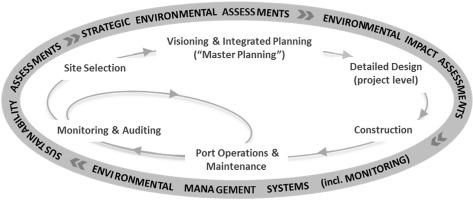当前位置:
X-MOL 学术
›
Ocean Coast Manage.
›
论文详情
Our official English website, www.x-mol.net, welcomes your
feedback! (Note: you will need to create a separate account there.)
The natural environment in port development: A ‘green handbrake’ or an equal partner?
Ocean & Coastal Management ( IF 4.8 ) Pub Date : 2021-01-01 , DOI: 10.1016/j.ocecoaman.2020.105390 S. Taljaard , J.H. Slinger , S. Arabi , S.P. Weerts , H. Vreugdenhil
Ocean & Coastal Management ( IF 4.8 ) Pub Date : 2021-01-01 , DOI: 10.1016/j.ocecoaman.2020.105390 S. Taljaard , J.H. Slinger , S. Arabi , S.P. Weerts , H. Vreugdenhil

|
Abstract Rapid urbanization of the coast, growing global trade, stakeholder emancipation and ongoing depletion of natural resources mean that ports can no longer operate and develop without acknowledging and incorporating societal and environmental considerations. Drawing primarily on first-hand experiences in South African ports, supplemented with learning taken from international literature, this paper proposes a conceptual change in the position of the natural environment in port development from that of a ‘green handbrake’ to ‘equal partner’. The argument for this conceptual change is developed in three stages. First, we merge two concepts emerging from the literature, namely natural capital (or natural infrastructure) and infrastructure systems, to embed the natural environment as an integral component or ‘equal partner’ in port development. We then identify practical avenues through which the profile (or value) of the natural environment can be enhanced in port development, drawing on concepts such as Building with Nature (BwN) and multi-use of natural capital. Finally, we build a framework for Integrated Port Management (IPM) by conceptually positioning and aligning environmental processes within the traditional port development cycle, as well as identifying the need for coordination across and continuity between individual environmental assessment processes. In essence, bridging the disconnect between natural environmental issues and port development requires early consideration of the natural environment in port development, and an acknowledgement of multi-use benefits from natural capital. Further, in the operations and maintenance phases, environmental management systems in ports should not only focus on environmental performance, but also embrace multi-use valuation of the natural environment (ecosystem services) to give purpose to the need for environmental protection. However, crucial to effective implementation of an Integrated Port Management (IPM) framework will be its integration in organisational processes, supported by collaborative institutional structures. Only then will the environment take its place as equal partner in port development.
中文翻译:

港口发展中的自然环境:“绿色手刹”还是平等伙伴?
摘要 沿海快速城市化、全球贸易增长、利益相关者解放和自然资源的持续枯竭意味着,如果不承认并纳入社会和环境因素,港口将无法运营和发展。本文主要借鉴南非港口的第一手经验,辅以国际文献的学习,提出了自然环境在港口发展中的地位从“绿色手刹”到“平等伙伴”的概念转变。这种概念变化的论证分三个阶段展开。首先,我们合并了文献中出现的两个概念,即自然资本(或自然基础设施)和基础设施系统,将自然环境作为港口发展的一个组成部分或“平等伙伴”嵌入。然后,我们利用自然建设 (BwN) 和自然资本的多用途等概念,确定可以在港口开发中增强自然环境特征(或价值)的实用途径。最后,我们通过在传统港口开发周期内从概念上定位和调整环境过程,以及确定各个环境评估过程之间协调和连续性的需求,为综合港口管理 (IPM) 建立框架。从本质上讲,要消除自然环境问题与港口发展之间的脱节,需要在港口发展中及早考虑自然环境,并承认自然资本的多用途收益。此外,在运营和维护阶段,港口的环境管理系统不仅应关注环境绩效,还应包括对自然环境(生态系统服务)的多用途评估,以实现环境保护的需要。然而,有效实施综合港口管理 (IPM) 框架的关键是将其整合到组织流程中,并得到协作机构结构的支持。只有这样,环境才能成为港口发展的平等伙伴。有效实施综合港口管理 (IPM) 框架的关键是将其整合到组织流程中,并得到协作机构结构的支持。只有这样,环境才能成为港口发展的平等伙伴。有效实施综合港口管理 (IPM) 框架的关键是将其整合到组织流程中,并得到协作机构结构的支持。只有这样,环境才能成为港口发展的平等伙伴。
更新日期:2021-01-01
中文翻译:

港口发展中的自然环境:“绿色手刹”还是平等伙伴?
摘要 沿海快速城市化、全球贸易增长、利益相关者解放和自然资源的持续枯竭意味着,如果不承认并纳入社会和环境因素,港口将无法运营和发展。本文主要借鉴南非港口的第一手经验,辅以国际文献的学习,提出了自然环境在港口发展中的地位从“绿色手刹”到“平等伙伴”的概念转变。这种概念变化的论证分三个阶段展开。首先,我们合并了文献中出现的两个概念,即自然资本(或自然基础设施)和基础设施系统,将自然环境作为港口发展的一个组成部分或“平等伙伴”嵌入。然后,我们利用自然建设 (BwN) 和自然资本的多用途等概念,确定可以在港口开发中增强自然环境特征(或价值)的实用途径。最后,我们通过在传统港口开发周期内从概念上定位和调整环境过程,以及确定各个环境评估过程之间协调和连续性的需求,为综合港口管理 (IPM) 建立框架。从本质上讲,要消除自然环境问题与港口发展之间的脱节,需要在港口发展中及早考虑自然环境,并承认自然资本的多用途收益。此外,在运营和维护阶段,港口的环境管理系统不仅应关注环境绩效,还应包括对自然环境(生态系统服务)的多用途评估,以实现环境保护的需要。然而,有效实施综合港口管理 (IPM) 框架的关键是将其整合到组织流程中,并得到协作机构结构的支持。只有这样,环境才能成为港口发展的平等伙伴。有效实施综合港口管理 (IPM) 框架的关键是将其整合到组织流程中,并得到协作机构结构的支持。只有这样,环境才能成为港口发展的平等伙伴。有效实施综合港口管理 (IPM) 框架的关键是将其整合到组织流程中,并得到协作机构结构的支持。只有这样,环境才能成为港口发展的平等伙伴。











































 京公网安备 11010802027423号
京公网安备 11010802027423号